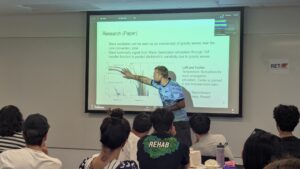CIERA’s Research Experiences for Teachers program inspires new classroom approaches through hands-on astronomy research
Every summer, teachers across Chicago seek meaningful professional development opportunities—but for a select few, their learning takes them straight to the stars.

RET participants and mentors discuss ways to incorporate their CIERA research projects into their classrooms.
At Northwestern’s Center for Interdisciplinary Exploration and Research in Astrophysics (CIERA), the Research Experiences for Teachers (RET) program, supported by the National Science Foundation, offers middle and high school educators the chance to engage in authentic astrophysics research alongside scientists, then translate that experience into dynamic classroom instruction. This summer, four teachers, Syed Ahmed, Julia Hodges, Makai DeNeve-Arnam, and Alexander Seifert, joined CIERA’s RET program, each bringing a unique background and a shared passion for STEM education.
For Syed Ahmed, a dual-language science teacher at Carl Von Linné Elementary School, participating in RET was a natural extension of his own love for learning.
“I’m currently in my second year of a doctoral program in instructional technology, so I’m trying to up my learning game,” Ahmed shared. “Part of why I became a teacher is because I love to learn. The more I learn, the more I can share with my students and model that for them.”
CIERA’s RET program pairs teachers with CIERA researchers, graduate students and postdocs on carefully selected, computer-based research projects that can be completed in six weeks. Teachers also learn alongside students in CIERA’s REACH program, developing skills in Python and scientific computing, while attending lectures, seminars, and curriculum-building workshops in partnership with the Baxter Center for Science Education.
This integrated model supports not just teacher learning, but curriculum transformation.
Julia Hodges, a high school teacher at Bennett Day School, saw RET as the perfect bridge between her industry experience and her classroom goals. With a degree in aerospace engineering from Notre Dame and a few years working in industry, Hodges now teaches a range of STEM subjects, from physics to robotics and recently began piloting an astronomy elective.
“Working with Bryan Scott [RET Coordinator and Mentor] on cosmology modeling has really shaped how I think about teaching,” says Hodges. “I now have a clearer vision for how to bring real data into the classroom and challenge students with big questions—like, how do we know the universe is 14 billion years old? Or how can we estimate the mass of Jupiter? After this experience, I have stronger ideas for reinforcing the math and science skills that are essential at the high school level.”
Throughout the program, RET participants work collaboratively to design inquiry-based lessons aligned with the Next Generation Science Standards (NGSS), helping students tackle big questions with computational tools. The summer culminates in research presentations delivered to fellow RET teachers, REACH students, and CIERA members.

Teacher final presentation.
Participants receive a stipend of $6,000, but according to Ahmed, the experience is worth far more:
“Space and earth science can feel very abstract for middle schoolers,” he said. “Through the RET program, I’ve learned how to make it concrete using tools like Python to visualize how scientists detect exoplanets.”
By blending scientific research, teacher development, and real-world classroom applications, CIERA’s RET program is helping shape a future where students are not just learning science—they’re doing it.
“It’s refreshing to see what the REACH high school students can do,” says Ahmed. They’ve blown me away. It makes me excited for what my own students are capable of.”
Scott compares teaching astronomy to the science itself.
“Modern astrophysics is home to some really exotic ideas, but it’s also a human story about how scientists work together over many years to build a collective understanding of where the universe came from and where it’s going,” says Scott. “Being able to share that story and support the RET teachers in adding their own pieces to it and taking those ideas back to their classrooms to inspire the next generation is, like astronomy itself, a humbling experience.”
Main image:
RET participants, mentors, and organizers celebrate completing the 6-week CIERA RET program. From left to right: Bryan Scott, RET Coordinator and mentor; Emma Kaufman, RET mentor; Makai DeNeve-Arnam; Alexander Seifert; Syed Ahmed; Julia Hodges; and James Schottelkotte, RET Program Director.

